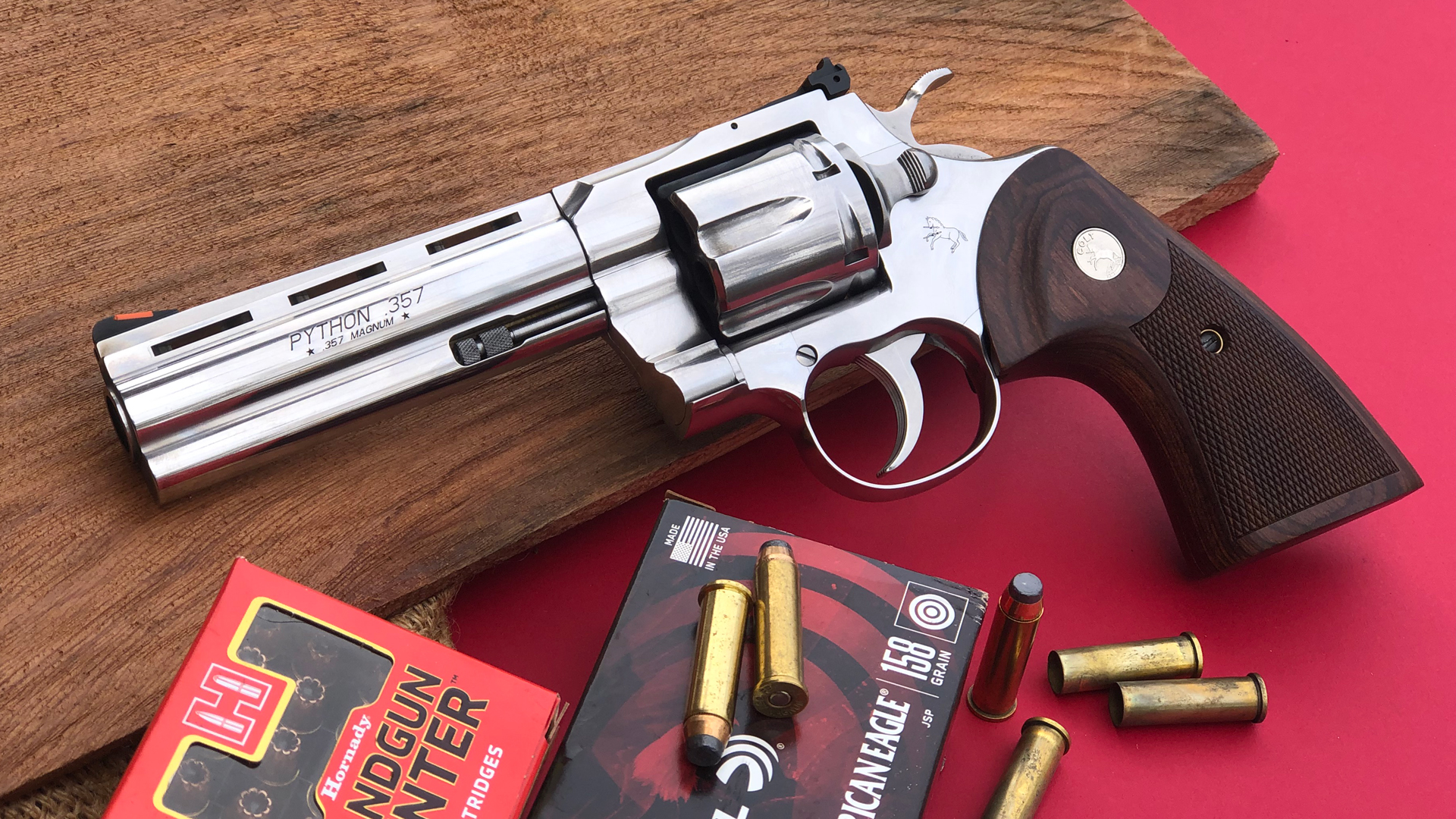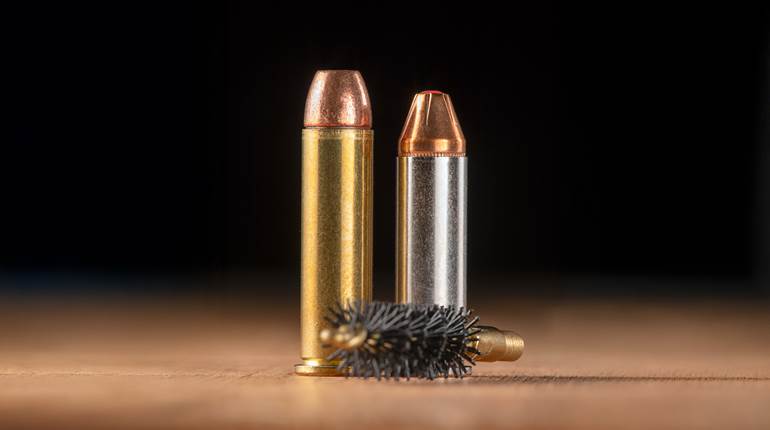
I was excited when Colt reintroduced the Python in 2020. I read Wiley Clapp’s excellent review and looked forward to seeing the new "Snake Gun." However, I became busy with other projects and wasn’t able to get one of the 4" or 6" guns to try. When Colt announced the return of the rare 3" version, I was again excited and was impressed by several I saw come through Guerrilla Armament, my local shop. But again, I didn’t actually get to shoot one of the new .357 Magnums. Last year, when Colt announced a run of 5" Pythons, I immediately arranged for a test gun. I’ve had the 5" Python on and off the range over the over the course of a few months, in between other reviews, and I can lead this review off with assurance—the latest snake was worth the wait.
The latest Colt is identical to its 3", 4.25" and 6" stablemates other than its 5" barrel. It has the same high polish stainless, same walnut target stocks etc. The difference and, I would argue, the magic is in that "in between" length, vent-ribbed, underlugged barrel. At first glance, the latest Python can be mistaken for its longer-barreled peer, but after a double-take, a shooter may notice that the overall appearance is more perfectly balanced. It looks neither long nor short, and those attractive Python lines work very well over the new barrel.

In hand, the odd tube hangs just right. There is "just enough" sight radius to give the shooter that long barrel effect, while the weight keeps the front sight where it needs to be without a sense of muzzle heaviness. My sample weighs in just over 43 ozs., right at the threshold between "steady" and "heavy."
The trigger shoe is flat across its face and serrated, and the single-action pull broke at 5 lbs. while the double-action stroke required 9.3 lbs. In dry fire, each trigger mode felt good and suggested that this could be a "hitting gun," one of those models that just make the shooter look good by hitting up to their best.
I fired a few representative groups from a rested position just to see what I could expect. The vintage Pythons had quite the reputation for accuracy and the machine rest results from the 2020 American Rifleman review proved the new model lived up. The 5" model I received for testing averaged 1.46" for the single representative groups across four loads; two target .38 Spl. loads and two .357 Mag. Anecdotally, every other load that I’ve fired in practice and in drills seemed to be impressively consistent.

Last year, I focused heavily on refining my double-action shooting. Accordingly, I did most of my shooting with the new Python in that mode. I quickly found that the double-action stroke, which felt pretty good in dry fire, was actually great when launching rounds. There was something to the Python where that last little bit of resistance as the hammer released and fell would bring the front sight into final, solid alignment. This Colt was consistently "inside of call" where the shots would impact just a shade better than I expected as the sight lifted in recoil.
The most extreme example of that happened on one of the first trips I had the Python out. I was noticing how well the shots were breaking in double-action, so I thought I would see if I could lob a few wadcutters onto an 8" plate from 73 yards. I held at the top of the plate and cycled the trigger carefully. The Colt gave that gentle wadcutter push into my grasp and the alto “Ting!” of 148 grains of flattened lead confirmed the hold. (Many subsonic handgun loads zeroed for a six-o’clock hold at 25 yards will connect at around 70 yards with a hold in the top third of the plate). I fired the rest of the cylinder and was rewarded with five out of six hits. Each shot felt very good.
As I walked toward the MGM steel plate, the splatter-marked group came into view, and I was speechless. The five lead splatters had formed a tight cluster that would have been exceptional at half that distance and still quite good at a quarter. If you shoot enough, these things happen; whether it was near perfect shots improbably aligned with the five most consistent rounds from the box of ammo or the "zig" of the ammo canceled out my "zag" as the shooter. Who knows? That small of a group at 70 yards is unlikely to happen again anytime soon, certainly not in double-action mode. But the Python made it happen that day. On other range days, I was able to reliably connect most shots with the plate, albeit with groups that used most of the available steel surface.

In shooting the Colt for groups, I had noticed that the Python handled the recoil of .357 Mag. loads well, and it got me to thinking how the revolver might compare for home defense. When I was a youngster growing up in Florida, many of the Highway Patrol carried the original Python on duty, as did plenty of other agencies. I didn’t doubt that the new Python could perform in that role, rather, I was curious what the difference might be between multiple shots at typical defensive distances.
I set up a target at about 6 yards, and on the signal from an AMG labs shot timer, I fired three rounds as quickly as possible into an 8" circle. I compared the Python with a Limited Edition M1911 from Colt, a 5" steel-frame .45 ACP setup much like many of the "combat custom" .45s from the 1990s. I have a considerable amount of time behind M1911s and had been shooting several for projects heavily in the time before this particular comparison, so the deck was stacked against the Python.
Nonetheless, the glossy revolver was quite controllable in rapid fire, averaging a flat second to launch three of the high-performance +P Punch .38s and just over a second to significantly "up" the muzzle energy to .357 level with the Hornady Critical Duty. The Python returns to target well, and the extra inch of barrel was as helpful in rapid fire as it was on the far-out precision targets. The Limited Edition M1911 won the "6 yard sprint" I was timing, but by a margin that would be difficult to ascertain without an electronic timer.
|
Handgun |
Cartridge |
Load |
Time In Seconds |
|
Colt Python 5” |
.38 Spl. +P |
Federal Punch 120-grain JHP |
1.00 |
|
Colt Python 5” |
.357 Mag. |
Hornady Critical Duty 135-grain FTX |
1.13 |
|
Colt Limited Edition M1911 |
.45 ACP |
Speer Gold Dot 230-grain JHP |
0.95 |
As good as the double-action pull is, it would be a foul to overlook the character of the single-action mode on this Colt. In single-action, the trigger breaks with a very slight movement as the sear yields, followed by a firm backstop with no overtravel. As with the DA, the break seems to freeze the front sight in place and allow excellent accuracy. On my most recent range trip with the Python, I wanted to refresh my memory on the single-action break, since so much of my shooting with the revolver had been in double-action.
I backed off 35 yards from a roughly index-card-sized 3"x6" steel target and began thumb-cocking some single-action attempts. There is something eminently satisfying about a .38 smacking that little target and swinging it on its hanger. After countless impacts on this target over the years, I can often tell the location of the hit by a combination of its tone and just how it swings, which allows me to make subtle adjustments in hold through a string of fire. The Python easily handled this challenging target. The Colt’s weight, balance and accuracy all combine to allow the difficult to not seem so.

One further note on the single-action mode. Cocking the Python was a sensory delight. Many revolvers have a great feel as the mechanical advantage of the hammer spins the cylinder into alignment and locks it into place. The Python was that and then some, the cylinder gliding smoothly into firm lockup as the wide, distinctive hammer spur moved to the rear. The soundtrack of that action under the thumb was a satisfying “tic-TOCK” as the hammer did its work. Much like fans of the Colt Single Action Army love the feeling and sound of the hammer counting off those storied four clicks on the way back, the Python’s pair will add to the shooter’s experience.
In several of the photos here, the Python is wearing some old-school Rogers-Safariland finger-groove combat stocks I found. These gave me an excellent hold on the Colt, and I think I like them best but, as wheelgunners tend to debate, I am unsure if I shoot better with them or the nicely fitted and shaped factory stocks.
I very much like the 5" Python, but it is not escaping without any slight counterpoints. The only real complaint I have is that this particular revolver barrel leads (fouling build-up) rather quickly and thoroughly with each make of hollow-base wadcutter I’ve tried. This is a disappointment, since I mostly load and shoot HBWCs. I like the revolver enough that I began developing loads with coated plain-base wadcutters from Bayou Bullets to avoid the issue.

The other item to point out is that the adjustable rear sight is a functional but somewhat inconvenient combination of a windage screw and setscrew. It held zero for me but led me to avoiding making minor adjustments when they were called for. Replacement sights are available from both Wilson Combat and Harrison Custom, but at the Python's price point, it would be reasonable to expect a fully adjustable, precise and robust sight such as have been on competitors’ revolvers since the 1950s.
The 5" Python captures that elusive balance all great firearms strive for. Graceful, attractive lines in an overall size and weight are also perfectly matched and suited for the handgun’s purpose. The visual and practical levels are but the first two; they attract the shooter and invite him to pick it up. Once there, when the shooter wraps a hand around the frame and extends the gun toward a target is when the hard judgement occurs. At least to my eye, and hands, the odd-length Python is well balanced across all three realms. It hangs steady in the grasp, the ounces of polished steel to front and rear reaching a near-perfect equilibrium and standing ready to launch magnums exactly where one intends to send them.



































